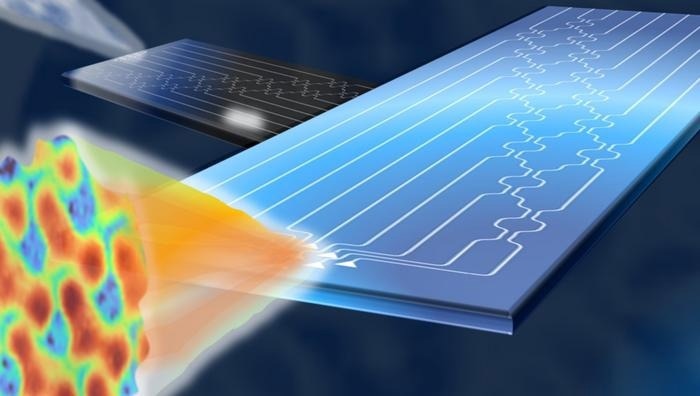Optical wireless technology might have cleared its hurdles. Collaborative research involving Politecnico di Milano, Scuola Superiore Sant'Anna in Pisa, the University of Glasgow, and Stanford University has yielded groundbreaking results.
 Chip. Image Credit: Politecnico Di Milano
Chip. Image Credit: Politecnico Di Milano
Their study, featured in the esteemed journal Nature Photonics, has developed photonic chips capable of calculating the ideal light shape mathematically. This breakthrough allows light to navigate through any environment seamlessly, including those that are unfamiliar or dynamically changing.
The challenge is familiar: light reacts sensitively to obstacles, no matter how small they may be. Consider how humans perceive objects through a frosted window or when the glasses fog up. A similar effect occurs with a light beam transmitting data in optical wireless systems. Though the information remains, it becomes highly distorted and exceedingly challenging to recover.
The outcomes of this research manifest as compact silicon chips acting as intelligent transceivers. Operating in pairs, these chips possess the ability to autonomously "compute" the optimal shape for a light beam to navigate through any environment with utmost effectiveness.
But there is more to these chips: they can also produce numerous overlapping beams, each with its distinct shape, and guide them without causing interference. This advancement significantly augments transmission capacity, aligning perfectly with the demands of forthcoming wireless systems.
Our chips are mathematical processors that make calculations with light very quickly and efficiently, almost with no energy consumption. The optical beams are generated through simple algebraic operations, essentially sums and multiplications, performed directly on the light signals and transmitted by micro-antennas directly integrated on the chips. This technology offers many advantages: extremely easy processing, high energy efficiency, and an enormous bandwidth exceeding 5000 GHz.
Francesco Morichetti, Head, Photonic Devices Lab, Politecnico di Milano
Andrea Melloni, Director, Polifab, Micro and Nanotechnology Center, Politecnico di Milano notes, “Today, all information is digital, but in fact, images, sounds, and all data are inherently analog. Digitization does allow for very complex processing, but as the volume of data increases, these operations become increasingly less sustainable in terms of energy and computation.”
“Today, there is great interest in returning to analog technologies, through dedicated circuits (analog co-processors) that will serve as enablers for the 5G and 6G wireless interconnection systems of the future. Our chips work just like that,” adds Andrea Melloni.
Analog computing using optical processors is crucial in numerous application scenarios that include mathematical accelerators for neuromorphic systems, high-performance computing (HPC) and artificial intelligence, quantum computers and cryptography, advanced localization, positioning and sensor systems, and in general, in all systems where the processing of large amounts of data at very high speed is required.
Marc Sorel, Professor, Electronics, Telecommunications, Computer Engineering, and Photonics Institute (TeCIP) Institute, Scuola Superiore Sant’Anna
This research is co-funded through the NRRP under the RESTART research and development program called “RESearch and innovation on future Telecommunications systems and networks, to make Italy more smart.”
Under the RESTART program, Professor Andrea Melloni from Politecnico di Milano and Professor Piero Castaldi from Istituto TeCIP, Scuola Superiore Sant’Anna Pisa, spearhead two projects: the 'HePIC' focused project and the 'Rigoletto' structural project. These initiatives are geared towards advancing next-generation photonic integrated circuits and optical transport networks crucial for supporting the forthcoming 6G infrastructure.
Journal Reference:
SeyedinNavadeh, S., et al. (2023). Determining the optimal communication channels of arbitrary optical systems using integrated photonic processors. Nature Photonics. doi/s41566-023-01330-w